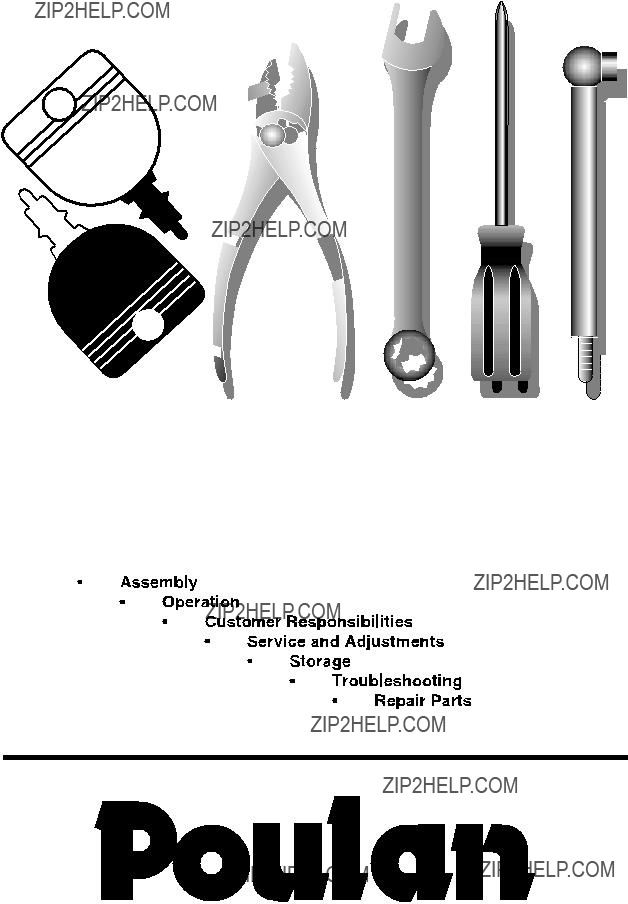
OWNER'S MANUAL
MODEL NO. PO165H42A
16.5 HP 42 Inch
Lawn Tractor
For Parts and Service, contact our authorized distributor: call
176085 Rev.1 2.23.01 RD
PRINTED IN U.S.A.

OWNER'S MANUAL
MODEL NO. PO165H42A
16.5 HP 42 Inch
Lawn Tractor
For Parts and Service, contact our authorized distributor: call
176085 Rev.1 2.23.01 RD
PRINTED IN U.S.A.

SAFETY RULES
Safe Operation Practices for
IMPORTANT: THIS CUTTING MACHINE IS CAPABLE OF AMPUTATING HANDS AND FEET AND THROWING OBJECTS.
FAILURE TO OBSERVE THE FOLLOWING SAFETY INSTRUCTIONS COULD RESULT IN SERIOUS INJURY OR DEATH.
I. GENERAL OPERATION
???Read, understand, and follow all instructions in the manual and on the machine before starting.
???Only allow responsible adults, who are familiar with the instructions, to operate the machine.
???Clear the area of objects such as rocks, toys, wire, etc., which could be picked up and thrown by the blade.
???Be sure the area is clear of other people before mowing. Stop machine if anyone enters the area.
???Never carry passengers.
???Do not mow in reverse unless absolutely necessary. Always look down and behind before and while backing.
???Be aware of the mower discharge direction and do not point it at anyone. Do not operate the mower without either the entire grass catcher or the guard in place.
???Slow down before turning.
???Never leave a running machine unattended. Always turn off blades, set parking brake, stop engine, and remove keys before dismounting.
???Turn off blades when not mowing.
???Stop engine before removing grass catcher or unclog- ging chute.
???Mow only in daylight or good artificial light.
???Do not operate the machine while under the influence of alcohol or drugs.
???Watch for traffic when operating near or crossing road- ways.
???Use extra care when loading or unloading the machine into a trailer or truck.
???Data indicates that operators, age 60 years and above, are involved in a large percentage of riding mower- related injuries. These operators should evaluate their ability to operate the riding mower safely enough to protect themselves and others from serious injury.
II. SLOPE OPERATION
Slopes are a major factor related to
DO:
???Mow up and down slopes, not across.
???Remove obstacles such as rocks, tree limbs, etc.
???Watch for holes, ruts, or bumps. Uneven terrain could overturn the machine. Tall grass can hide obstacles.
???Use slow speed. Choose a low gear so that you will not have to stop or shift while on the slope.
???Follow the manufacturer???s recommendations for wheel weights or counterweights to improve stability.
???Use extra care with grass catchers or other attach- ments. These can change the stability of the machine.
???Keep all movement on the slopes slow and gradual. Do not make sudden changes in speed or direction.
???Avoid starting or stopping on a slope. If tires lose traction, disengage the blades and proceed slowly straight down the slope.
DO NOT:
???Do not turn on slopes unless necessary, and then, turn slowly and gradually downhill, if possible.
???Do not mow near
???Do not mow on wet grass. Reduced traction could cause sliding.
???Do not try to stabilize the machine by putting your foot on the ground.
???Do not use grass catcher on steep slopes.
III. CHILDREN
Tragic accidents can occur if the operator is not alert to the presence of children. Children are often attracted to the machine and the mowing activity. Never assume that children will remain where you last saw them.
???Keep children out of the mowing area and under the watchful care of another responsible adult.
???Be alert and turn machine off if children enter the area.
???Before and when backing, look behind and down for small children.
???Never carry children. They may fall off and be seriously injured or interfere with safe machine operation.
???Never allow children to operate the machine.
???Use extra care when approaching blind corners, shrubs, trees, or other objects that may obscure vision.
IV. SERVICE
???Use extra care in handling gasoline and other fuels. They are flammable and vapors are explosive.
-Use only an approved container.
-Never remove gas cap or add fuel with the engine running. Allow engine to cool before refueling. Do not smoke.
-Never refuel the machine indoors.
-Never store the machine or fuel container inside where there is an open flame, such as a water heater.
???Never run a machine inside a closed area.
???Keep nuts and bolts, especially blade attachment bolts, tight and keep equipment in good condition.
???Never tamper with safety devices. Check their proper operation regularly.
???Keep machine free of grass, leaves, or other debris
???Stop and inspect the equipment if you strike an object. Repair, if necessary, before restarting.
???Never make adjustments or repairs with the engine running.
???Grass catcher components are subject to wear, dam- age, and deterioration, which could expose moving parts or allow objects to be thrown. Frequently check compo- nents and replace with manufacturer's recommended parts, when necessary.
???Mower blades are sharp and can cut. Wrap the blade(s) or wear gloves, and use extra caution when servicing them.
???Check brake operation frequently. Adjust and service as required.
2
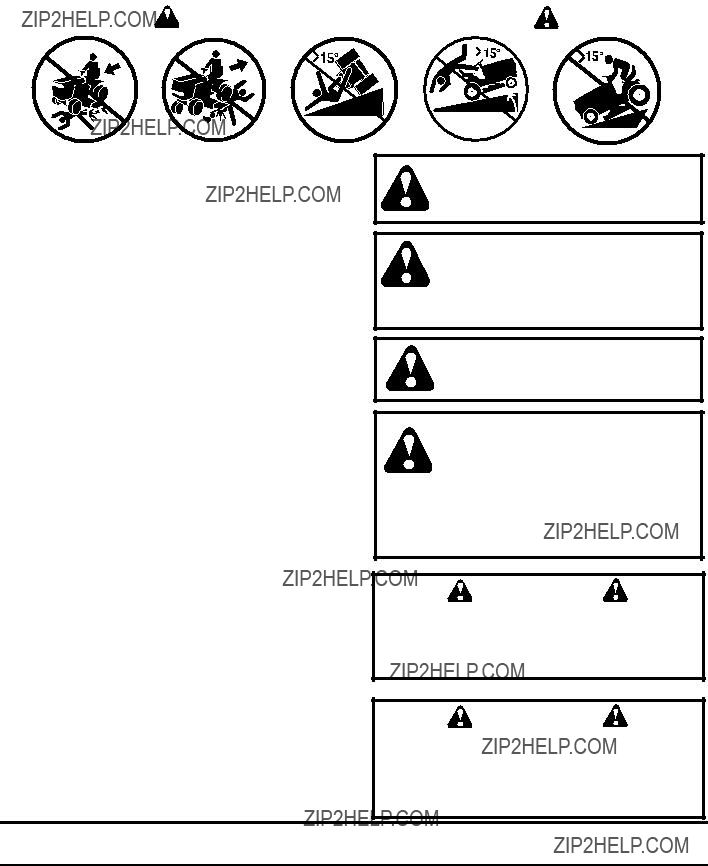
SAFETY RULES
 Safe Operation Practices for
Safe Operation Practices for
???Be sure the area is clear of other people before mowing. Stop machine if anyone enters the area.
???Never carry passengers or children even with the blades off.
???Do not mow in reverse unless absolutely necessary. Always look down and behind before and while backing.
???Never carry children. They may fall off and be seriously injured or interfere with safe machine operation.
???Keep children out of the mowing area and under the watchful care of another responsible adult.
???Be alert and turn machine off if children enter the area.
???Before and when backing, look behind and down for small children.
???Mow up and down slopes (15?? Max), not across.
???Remove obstacles such as rocks, tree limbs, etc.
???Watch for holes, ruts, or bumps. Uneven terrain could over- turn the machine. Tall grass can hide obstacles.
???Use slow speed. Choose a low gear so that you will not have to stop or shift while on the slope.
???Avoid starting or stopping on a slope. If tires lose traction, disengage the blades and proceed slowly straight down the slope.
???If machine stops while going uphill, disengage blades, shift into reverse and back down slowly.
???Do not turn on slopes unless necessary, and then, turn slowly and gradually downhill, if possible.
Look for this symbol to point out im- portant safety precautions. It means CAUTION!!! BECOME ALERT!!! YOUR
SAFETY IS INVOLVED.
CAUTION: In order to prevent acciden- tal starting when setting up, transport- ing, adjusting or making repairs, al- ways disconnect spark plug wire and placewirewhereitcannotcontactspark plug.
CAUTION: Do not coast down a hill in neutral, you may lose control of the tractor.
CAUTION: Tow only the attachments that are recommended by and comply with specifications of the manufacturer of your tractor. Use common sense when towing. Operate only at the low- est possible speed when on a slope. Too heavy of a load, while on a slope, is dangerous. Tires can lose traction with the ground and cause you to lose control of your tractor.
WARNING
Engine exhaust, some of its constituents, and cer- tain vehicle components contain or emit chemicals known to the State of California to cause cancer and birth defects or other reproductive harm.
WARNING
Battery posts, terminals and related accessories contain lead and lead compounds, chemicals known to the State of California to cause cancer and birth defects or other reproductive harm. Wash hands after handling.
TABLE OF CONTENTS
PRODUCT SPECIFICATIONS
CONGRATULATIONS on your purchase of a new tractor. It has been designed, engineered and manufactured to give you the best possible dependability and performance.
Should you experience any problem you cannot easily remedy, please contact your nearest authorized service center/department. We have competent,
Please read and retain this manual. The instructions will enable you to assemble and maintain your tractor properly. Always observe the ???SAFETY RULES???.
CUSTOMER RESPONSIBILITIES
???Read and observe the safety rules.
???Follow a regular schedule in maintaining, caring for and using your tractor.
???Follow the instructions under ???Customer Responsibili- ties??? and ???Storage??? sections of this owner???s manual.
WARNING: This tractor is equipped with an internal com- bustion engine and should not be used on or near any unimproved
A spark arrester for the muffler is available through your nearest authorized service center/department (See RE- PAIR PARTS section of this manual).
4

UNASSEMBLED PARTS
5
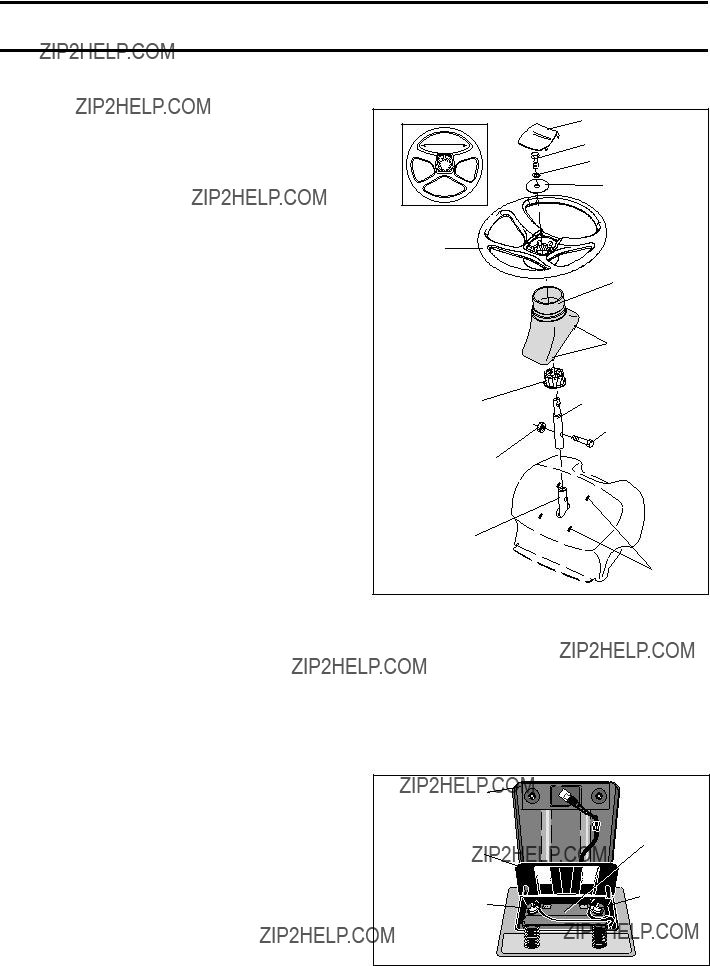
ASSEMBLY
Your new tractor has been assembled at the factory with exception of those parts left unassembled for shipping purposes. To ensure safe and proper operation of your tractor all parts and hardware you assemble must be tightened securely. Use the correct tools as necessary to insure proper tightness.
TOOLS REQUIRED FOR ASSEMBLY
A socket wrench set will make assembly easier. Standard wrench sizes are listed.
When right or left hand is mentioned in this manual, it means when you are in the operating position (seated behind the steering wheel).
TO REMOVE TRACTOR FROM CARTON
UNPACK CARTON
???Remove all accessible loose parts and parts cartons from carton.
???Cut, from top to bottom, along lines on all four corners of carton, and lay panels flat.
???Check for any additional loose parts or cartons and remove.
BEFORE REMOVING TRACTOR FROM
SKID
ATTACH STEERING WHEEL (See Fig. 1)
ASSEMBLE EXTENSION SHAFT AND BOOT
???Slide extension shaft onto lower steering shaft. Align mounting holes in extension and lower shafts and install 5/16 hex bolt and locknut. Tighten securely.
???Place tabs of steering boot over tab slots in dash and push down to secure.
INSTALL STEERING WHEEL
???Position front wheels of the tractor so they are pointing straight forward.
???Remove steering wheel adapter from steering wheel and slide adapter onto steering shaft extension.
???Position steering wheel so cross bars are horizontal (left to right) and slide inside boot and onto adapter.
???Assemble large flat washer, 3/8 lock washer, 3/8 hex bolt and tighten securely.
???Snap steering wheel insert into center of steering wheel.
???Remove protective materials from tractor hood and grill.
IMPORTANT: CHECK FOR AND REMOVE ANY STAPLES
IN SKID THAT MAY PUNCTURE TIRES WHERE TRACTOR
IS TO ROLL OFF SKID.
FIG. 1
HOW TO SET UP YOUR TRACTOR
CHECK BATTERY (See Fig. 2)
???Lift seat pan to raised position and open battery box door.
???If this battery is put into service after month and year indicated on label (label located between terminals) charge battery for minimum of one hour at
SEAT PAN
LABEL
BATTERY
BOX DOOR
TERMINAL
TERMINAL

ASSEMBLY
INSTALL SEAT (See Fig. 3)
Adjust seat before tightening adjustment bolt.
???Remove adjustment bolt, lock washer and flat washer securing seat to cardboard packing and set aside for assembly of seat to tractor.
???Pivot seat upward and remove from the cardboard packing. Remove the cardboard packing and discard.
???Place seat on seat pan so head of shoulder bolt is positioned over large slotted hole in pan.
???Push down on seat to engage shoulder bolt in slot and pull seat towards rear of tractor.
???Pivot seat and pan forward and assemble adjustment bolt, lockwasher and flat washer loosely. Do not tighten
???Lower seat into operating position and sit on seat.
???Slide seat until a comfortable position is reached which allows you to press clutch/brake pedal all the way down.
???Get off seat without moving its adjusted position.
???Raise seat and tighten adjustment bolt securely.
FIG. 3
NOTE: You may now roll or drive your tractor off the skid. Follow the appropriate instruction below to remove the tractor from the skid.
TO ROLL TRACTOR OFF SKID (See Operation section, page 10, for location and function of controls)
???Press lift lever plunger and raise attachment lift lever to its highest position.
???Releaseparkingbrakebydepressingclutch/brakepedal.
???Place freewheel control in freewheeling position to disengage transmission (See ???TO TRANSPORT??? in the Operation section of this manual).
???Roll tractor forward off skid.
???Remove banding holding deflector shield up against tractor.
TO DRIVE TRACTOR OFF SKID (See Opera- tion section, page 10, for location and func- tion of controls)
 WARNING: Before starting, read, understand and follow all instructions in the Operation section of this manual. Be sure tractor is in a
WARNING: Before starting, read, understand and follow all instructions in the Operation section of this manual. Be sure tractor is in a
???Be sure all the above assembly steps have been completed.
???Check engine oil level and fill fuel tank with gasoline.
???Place freewheel control in "transmission engaged" po- sition.
???Sit on seat in operating position, depress clutch/brake pedal and set the parking brake.
???Place motion control lever in neutral (N) position.
???Press lift lever plunger and raise attachment lift lever to its highest position.
???Start the engine. After engine has started, move throttle control to idle position.
???Release parking brake.
???Slowly move the motion control lever forward and slowly drive tractor off skid.
???Apply brake to stop tractor, set parking brake and place motion control lever in neutral position.
???Turn ignition key to "OFF" position.
Continue with the instructions that follow.
7

ASSEMBLY
CHECK TIRE PRESSURE
The tires on your tractor were overinflated at the factory for shipping purposes. Correct tire pressure is important for best cutting performance.
???Reduce tire pressure to PSI shown in ???PRODUCT SPECIFICATIONS??? section of this manual.
CHECK DECK LEVELNESS
For best cutting results, mower housing should be properly leveled. See ???TO LEVEL MOWER HOUSING??? in the Service and Adjustments section of this manual.
CHECK FOR PROPER POSITION OF ALL
BELTS
See the figures that are shown for replacing motion and mower blade drive belts in the Service and Adjustments section of this manual. Verify that the belts are routed correctly.
CHECK BRAKE SYSTEM
After you learn how to operate your tractor, check to see that the brake is properly adjusted. See ???TO ADJUST BRAKE??? in the Service and Adjustments section of this manual.
!CHECKLIST
BEFOREYOUOPERATEANDENJOYYOURNEW TRAC-
TOR, WE WISH TO ASSURE THAT YOU RECEIVE THE
BEST PERFORMANCE AND SATISFACTION FROM THIS
QUALITY PRODUCT.
PLEASE REVIEW THE FOLLOWING CHECKLIST:
!All assembly instructions have been completed.
!No remaining loose parts in carton.
!Battery is properly prepared and charged. (Minimum 1 hour at 6 amps).
!Seat is adjusted comfortably and tightened securely.
!All tires are properly inflated. (For shipping purposes, the tires were overinflated at the factory).
!Be sure mower deck is properly leveled
!Check mower and drive belts. Be sure they are routed properly around pulleys and inside all belt keepers.
!Check wiring. See that all connections are still secure and wires are properly clamped.
!Before driving tractor, be sure freewheel control is in drive position.
WHILE LEARNING HOW TO USE YOUR TRACTOR, PAY
EXTRA ATTENTION TO THE FOLLOWING IMPORTANT
ITEMS:
!Engine oil is at proper level.
!Fuel tank is filled with fresh, clean, regular unleaded gasoline.
!Become familiar with all controls - their location and function. Operate them before you start the engine.
!Be sure brake system is in safe operating condition.
!It is important to purge the transmission before operating your tractor for the first time. Follow proper starting and transmission purging instructions (See ???TO START ENGINE??? and ???PURGE TRANSMISSION??? in the Opera- tion section of this manual).
8

OPERATION
These symbols may appear on your tractor or in literature supplied with the product. Learn and understand their meaning.
P
9

OPERATION
KNOW YOUR TRACTOR
READ THIS OWNER'S MANUAL AND SAFETY RULES BEFORE OPERATING YOUR TRACTOR
Compare the illustrations with your tractor to familiarize yourself with the locations of various controls and adjustments. Save this manual for future reference.
FIG. 4
Our tractors conform to the safety standards of the American National Standards Institute.
ATTACHMENT CLUTCH LEVER: Used to engage the mower blades, or other attachments mounted to your tractor. LIGHT SWITCH: Turns the headlights on and off.
THROTTLE/CHOKE CONTROL: Used for starting and controling engine speed.
CLUTCH/BRAKE PEDAL: Used for declutching and brak- ing the tractor and starting the engine.
PARKING BRAKE: Locks clutch/brake pedal into the brake position.
FREEWHEEL CONTROL: Disengages transmission for pushing or slowly towing the tractor with the engine off.
MOTION CONTROL LEVER: Selects the speed and direction of tractor.
ATTACHMENT LIFT LEVER: Used to raise and lower the mower deck or other attachments mounted to your tractor. LIFT LEVER PLUNGER: Used to release attachment lift lever when changing its position.
IGNITION SWITCH: Used for starting and stopping the engine.
10
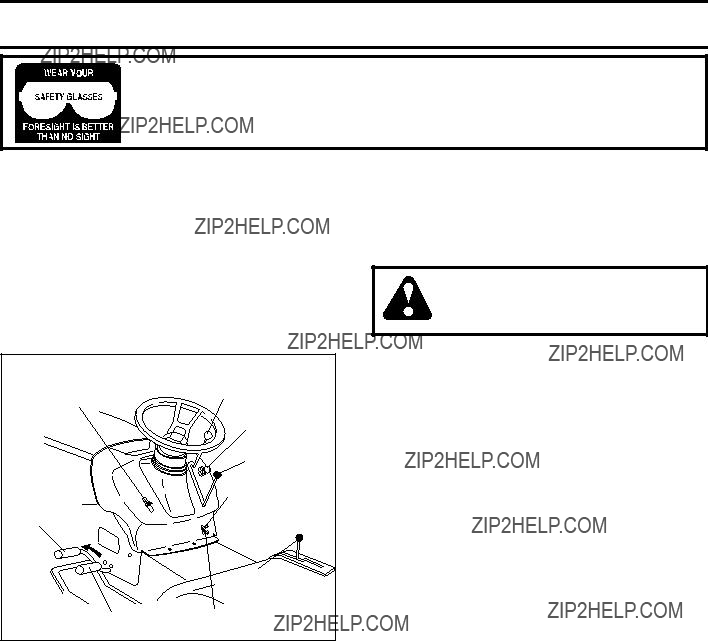
OPERATION
The operation of any tractor can result in foreign objects thrown into the eyes, which can result in severe eye damage. Always wear safety glasses or eye shields while operating your tractor or performing any adjustments or repairs. We recommend a wide vision safety mask over spectacles or standard safety glasses.
HOW TO USE YOUR TRACTOR
TO SET PARKING BRAKE (See Fig. 5)
Your tractor is equipped with an operator presence sensing switch. When engine is running, any attempt by the operator to leave the seat without first setting the parking brake will shut off the engine.
???Depress clutch/brake pedal into full ???BRAKE??? position and hold.
???Place parking brake lever in ???ENGAGED??? position and release pressure from clutch/brake pedal. Pedal should remain in ???BRAKE??? position. Make sure parking brake will hold tractor secure.
FIG. 5
STOPPING (See Fig. 5)
MOWER BLADES -
???To stop mower blades,move attachment clutch lever to ???DISENGAGED??? position.
GROUND DRIVE -
???To stop ground drive, depress clutch/brake pedal into full ???BRAKE??? position.
???Move motion control lever to neutral (N) position.
IMPORTANT: THE MOTION CONTROL LEVER DOES
NOT RETURN TO NEUTRAL (N) POSITION WHEN THE
CLUTCH/BRAKE PEDAL IS DEPRESSED.
ENGINE -
???Move throttle control to slow position.
NOTE: Failure to move throttle control to slow position and allowing engine to idle before stopping may cause engine to ???backfire???.
???Turn ignition key to ???OFF??? position and remove key. Always remove key when leaving tractor to prevent unauthorized use.
IMPORTANT: LEAVING THE IGNITION SWITCH IN ANY
POSITION OTHER THAN "OFF" WILL CAUSE THE
BATTERY TO BE DISCHARGED, (DEAD).
NOTE: Under certain conditions when tractor is standing idle with the engine running, hot engine exhaust gases may cause ???browning??? of grass. To eliminate this possibility, always stop engine when stopping tractor on grass areas.
CAUTION: Always stop tractor com- pletely, as described above, before leav- ing the operator's position; to empty grass catcher, etc.
TO USE THROTTLE CONTROL (See Fig. 5)
Always operate engine at full throttle.
???Operating engine at less than full throttle reduces the battery charging rate.
???Full throttle offers the best bagging and mower perfor- mance.
TO MOVE FORWARD AND BACKWARD (See
Fig. 5)
The direction and speed of movement is controlled by the motion control lever.
???Start tractor with motion control lever in neutral (N) position.
???Release parking brake and clutch/brake pedal.
???Slowly move motion control lever to desired position.
TO ADJUST MOWER CUTTING HEIGHT (See
Fig. 5)
The position of the attachment lift lever determines the cutting height.
???Grasp lift lever.
???Press plunger with thumb and move lever to desired position.
The cutting height range is approximately
???The average lawn should be cut to approximately
???For best cutting performance, grass over 6 inches in height should be mowed twice. Make the first cut relatively high; the second to desired height.

OPERATION
TO ADJUST GAUGE WHEELS (See Fig. 6)
Gauge wheels are properly adjusted when they are slightly off the ground when mower is at the desired cutting height in operating position. Gauge wheels then keep the deck in proper position to help prevent scalping in most terrain conditions.
???Adjust gauge wheels with tractor on a flat level surface.
???Adjust mower to desired cutting height (See ???TO AD- JUST MOWER CUTTING HEIGHT??? in the Operation section of this manual).
???With mower in desired height of cut position, gauge wheels should be assembled so they are slightly off the ground. Install gauge wheel in appropriate hole with shoulder bolt, 17/32 washer, 3/8 washer, and
???Repeat for opposite side installing gauge wheel in same adjustment hole.
FIG. 6
TO OPERATE MOWER (See Fig. 7)
Your tractor is equipped with an operator presence sensing switch. Any attempt by the operator to leave the seat with the engine running and the attachment clutch engaged will shut off the engine.
???Select desired height of cut.
???Start mower blades by engaging attachment clutch control.
???TO STOP MOWER BLADES - disengage attachment clutch control.
CAUTION: Do not operate the mower without either the entire grass catcher, on mowers so equipped, or the deflector shield in place.
"ENGAGED" POSITION
ATTACHMENT
LIFT LEVER
HIGH POSI-
TION
LOW
POSITION
DEFLECTOR
SHIELD
ATTACHMENT
CLUTCH LEVER
"DISENGAGED"
POSITION
TO OPERATE ON HILLS
CAUTION: Do not drive up or down hills with slopes greater than 15?? and do not drive across any slope.
???Choose the slowest speed before starting up or down hills.
???Avoid stopping or changing speed on hills.
???If slowing is necessary, move throttle control lever to slower position.
???If stopping is absolutely necessary, push clutch/brake pedal quickly to brake position and engage parking brake.
???Move motion control lever to neutral (N) position.
IMPORTANT: THE MOTION CONTROL LEVER DOES
NOT RETURN TO NEUTRAL (N) POSITION WHEN THE
CLUTCH/BRAKE PEDAL IS DEPRESSED.
???To restart movement, slowly release parking brake and clutch/brake pedal.
???Slowly move motion control lever to slowest setting.
???Make all turns slowly.
TO TRANSPORT (See Figs. 4 and 8)
When pushing or towing your tractor, be sure to disengage transmission by placing freewheel control in freewheeling position. Free wheel control is located at the rear drawbar of tractor.
???Raise attachment lift to highest position with attach- ment lift control.
???Pull freewheel control out and down into the slot and release so it is held in the disengaged position.
???Do not push or tow tractor at more than two (2) MPH.
???To reengage transmission, reverse above procedure.
NOTE: To protect hood from damage when transporting your tractor on a truck or a trailer, be sure hood is closed and secured to tractor. Use an appropriate means of tying hood to tractor (rope, cord, etc.).
FIG. 8
TOWING CARTS AND OTHER ATTACHMENTS
Tow only the attachments that are recommended by and comply with specifications of the manufacturer of your tractor. Use common sense when towing. Too heavy of a load, while on a slope, is dangerous. Tires can lose traction with the ground and cause you to lose control of your tractor.

OPERATION
BEFORE STARTING THE ENGINE
CHECK ENGINE OIL LEVEL
???The engine in your tractor has been shipped, from the factory, already filled with summer weight oil.
???Check engine oil with tractor on level ground.
???Remove oil fill cap/dipstick and wipe clean, reinsert the dipstick and screw cap tight, wait for a few seconds, remove and read oil level. If necessary, add oil until ???FULL??? mark on dipstick is reached. Do not overfill.
???For cold weather operation you should change oil for easier starting (See ???OIL VISCOSITY CHART??? in the Customer Responsibilities section of this manual).
???To change engine oil, see the Customer Responsibili- ties section in this manual.
ADD GASOLINE
???Fill fuel tank. Use fresh, clean, regular unleaded gasoline with a minimum of 87 octane. (Use of leaded gasoline will increase carbon and lead oxide deposits and reduce valve life). Do not mix oil with gasoline. Purchase fuel in quantities that can be used within 30 days to assure fuel freshness.
IMPORTANT: WHEN OPERATING IN TEMPERATURES BELOW 32??F(0??C), USE FRESH, CLEAN WINTER GRADE
GASOLINE TO HELP INSURE GOOD COLD WEATHER
STARTING.
WARNING: Experience indicates that alcohol blended fuels (called gasohol or using ethanol or methanol) can attract moisture which leads to separation and formation of acids during storage. Acidic gas can damage the fuel system of an engine while in storage. To avoid engine problems, the fuel system should be emptied before storage of 30 days or longer. Drain the gas tank, start the engine and let it run until the fuel lines and carburetor are empty. Use fresh fuel next season. See Storage Instructions for additional information. Never use engine or carburetor cleaner products in the fuel tank or permanent damage may occur.
CAUTION: Fill to bottom of gas tank filler neck. Do not overfill. Wipe off any spilled oil or fuel. Do not store, spill or use gasoline near an open flame.
TO START ENGINE (See Fig. 4)
When starting the engine for the first time or if the engine has run out of fuel, it will take extra cranking time to move fuel from the tank to the engine.
???Be sure freewheel control is in the transmission engaged position.
???Sit on seat in operating position, depress clutch/brake pedal and set parking brake.
???Place motion control lever in neutral (N) position.
???Move attachment clutch to ???DISENGAGED??? position.
???Move throttle control to choke position.
NOTE: Before starting, read the warm and cold starting procedures below.
???Insert key into ignition and turn key clockwise to ???START??? position and release key as soon as engine starts. Do not run starter continuously for more than fifteen seconds per minute. If the engine does not start after several attempts, move throttle control to fast position, wait a few minutes and try again. If engine still does not start, move the throttle control back to the choke position and retry.
WARM WEATHER STARTING (50??F and above)
???When engine starts, move the throttle control to the fast position.
???The attachments and ground drive can now be used. If the engine does not accept the load, restart the engine and allow it to warm up for one minute using the choke as described above.
COLD WEATHER STARTING ( 50??F and below)
???When engine starts, allow engine to run with the throttle control in the choke position until the engine runs roughly, then move throttle control to fast position. This may require an engine
AUTOMATIC TRANSMISSION WARM UP
???Before driving the unit in cold weather, the transmission should be warmed up as follows:
???Be sure the tractor is on level ground.
???Place the motion control lever in neutral. Release the parking brake and let the clutch/brake
slowly return to operating position.
???Allow one minute for transmission to warm up. This can be done during the engine warm up period.
???The attachments can also be used during the engine
NOTE: If at a high altitude (above 3000 feet) or in cold temperatures (below 32 F) the carburetor fuel mixture may need to be adjusted for best engine performance. See ???TO ADJUST CARBURETOR??? in the Service and Adjustments section of this manual.
PURGE TRANSMISSION
CAUTION: Never engage or disengage freewheel lever while the engine is run- ning.
To ensure proper operation and performance, it is recom- mended that the transmission be purged before operating tractor for the first time. This procedure will remove any trapped air inside the transmission which may have devel- oped during shipping of your tractor.
IMPORTANT: SHOULD YOUR TRANSMISSION REQUIRE
REMOVAL FOR SERVICE OR REPLACEMENT, IT
SHOULD BE PURGED AFTER REINSTALLATION BEFORE
OPERATING THE TRACTOR.
???Place tractor safely on level surface with engine off and parking brake set.
???Disengage transmission by placing freewheel control in freewheeling position (See ???TO TRANSPORT??? in this section of manual).
13

OPERATION
???Sitting in the tractor seat, start engine. After the engine is running, move throttle control to slow position. With motion control lever in neutral (N) position, slowly disengage clutch/brake pedal.
???Move motion control lever to full forward position and hold for five (5) seconds. Move lever to full reverse position and hold for five (5) seconds. Repeat this procedure three (3) times.
NOTE: During this procedure there will be no movement of drive wheels. The air is being removed from hydraulic drive system.
???Move motion control lever to neutral (N) position. Shut- off engine and set parking brake.
???Engage transmission by placing freewheel control in driving position (See ???TO TRANSPORT??? in this section of manual).
???Sitting in the tractor seat, start engine. After the engine is running, move throttle control to half (1/2) speed. With motion control lever in neutral (N) position, slowly disengage clutch/brake pedal.
???Slowly move motion control lever forward, after the tractor moves approximately five (5) feet, slowly move motion control lever to reverse position. After the tractor moves approximately five (5) feet return the motion control lever to the neutral (N) position. Repeat this procedure with the motion control lever three (3) times.
???Your tractor is now purged and now ready for normal operation.
MOWING TIPS
???Mower should be properly leveled for best mowing performance. See ???TO LEVEL MOWER HOUSING??? in the Service and Adjustments section of this manual.
???The left hand side of mower should be used for trimming.
???Drive so that clippings are discharged onto the area that has been cut. Have the cut area to the right of the machine. This will result in a more even distribution of clippings and more uniform cutting.
???When mowing large areas, start by turning to the right so that clippings will discharge away from shrubs, fences, driveways, etc. After one or two rounds, mow in the opposite direction making left hand turns until finished (See Fig. 9).
???If grass is extremely tall, it should be mowed twice to reduce load and possible fire hazard from dried clip- pings. Make first cut relatively high; the second to the desired height.
???Do not mow grass when it is wet. Wet grass will plug mower and leave undesirable clumps. Allow grass to dry before mowing.
???Always operate engine at full throttle when mowing to assure better mowing performance and proper dis- charge of material. Regulate ground speed by selecting a low enough gear to give the mower cutting perfor- mance as well as the quality of cut desired.
???When operating attachments, select a ground speed that will suit the terrain and give best performance of the attachment being used.
FIG. 9
14

CUSTOMER RESPONSIBILITIES
MAINTENANCE SCHEDULE
FILL IN DATES
AS YOU COMPLETE
REGULAR SERVICE
7
4
6
5
5
1,2,3
2
2
1, 2
2
2
1 - Change more often when operating under a heavy load or in high ambient temperatures. 2 - Service more often when operating in dirty or dusty conditions.
3 - If equipped with oil filter, change oil every 50 hours.
4 - Replace blades more often when mowing in sandy soil.
5 - If equipped with adjustable system.
6 - Not required if equipped with
Do not overtighten.
GENERAL RECOMMENDATIONS
The warranty on this tractor does not cover items that have been subjected to operator abuse or negligence. To receive full value from the warranty, operator must maintain tractor as instructed in this manual.
Some adjustments will need to be made periodically to properly maintain your tractor.
All adjustments in the Service and Adjustments section of this manual should be checked at least once each season.
???Once a year you should replace the spark plug, clean or replace air filter, and check blades and belts for wear. A new spark plug and clean air filter assure proper
LUBRICATION CHART
BEFORE EACH USE
???Check engine oil level.
???Check brake operation.
???Check tire pressure.
???Check operator presence and interlock systems for proper operation.
???Check for loose fasteners.
15
??SAE 30 OR 10W30 MOTOR OIL
??REFER TO CUSTOMER RESPONSIBILITIES ???ENGINE???
SECTION
IMPORTANT: DO NOT OIL OR GREASE THE PIVOT POINTS
WHICH HAVE SPECIAL NYLON BEARINGS. VISCOUS LUBRI-
CANTS WILL ATTRACT DUST AND DIRT THAT WILL SHORTEN
THE LIFE OF THE
FEEL THEY MUST BE LUBRICATED, USE ONLY A DRY, POW-
DERED GRAPHITE TYPE LUBRICANT SPARINGLY.
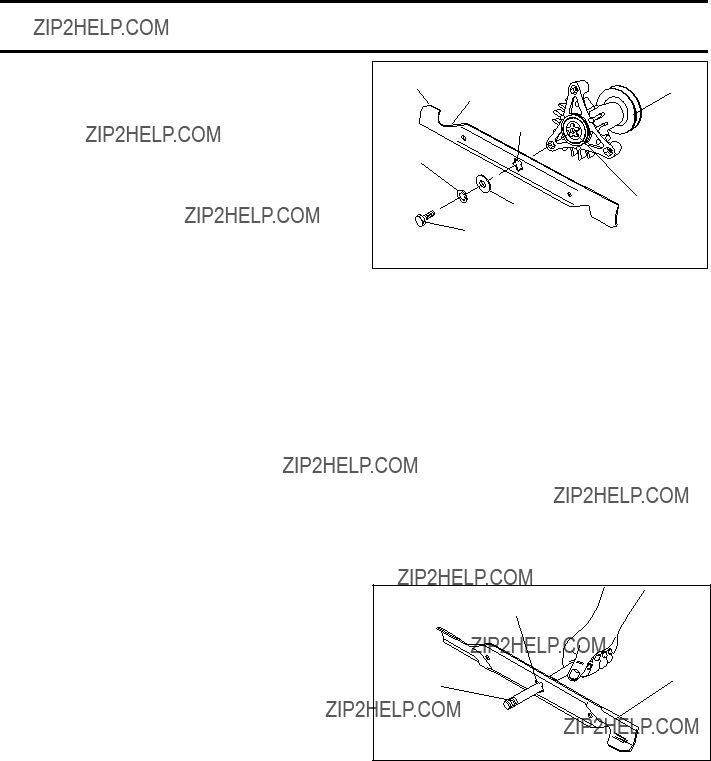
CUSTOMER RESPONSIBILITIES
TRACTOR
Always observe safety rules when performing any mainte- nance.
BRAKE OPERATION
If tractor requires more than six (6) feet stopping distance at high speed in highest gear, then brake must be adjusted. (See ???TO ADJUST BRAKE??? in the Service and Adjustments section of this manual).
TIRES
???Maintain proper air pressure in all tires (See ???PRODUCT SPECIFICATIONS??? section of this manual).
???Keep tires free of gasoline, oil, or insect control chemi- cals which can harm rubber.
???Avoid stumps, stones, deep ruts, sharp objects and other hazards that may cause tire damage.
NOTE: To seal tire punctures and prevent flat tires due to slow leaks, tire sealant may be purchased from your local parts dealer. Tire sealant also prevents tire dry rot and corrosion.
OPERATOR PRESENCE SYSTEM
Be sure operator presence and interlock systems are work- ing properly. If your tractor does not function as described, repair the problem immediately.
???The engine should not start unless the clutch/brake pedal is fully depressed and attachement clutch control is in the disengaged position.
???When the engine is running, any attempt by the operator to leave the seat without first setting the parking brake should shut off the engine.
???When the engine is running and the attachment clutch is engaged, any attempt by the operator to leave the seat should shut off the engine.
???The attachment clutch should never operate unless the operator is in the seat.
BLADE CARE
For best results mower blades must be kept sharp. Replace bent or damaged blades.
BLADE REMOVAL (See Fig. 10)
???Raise mower to highest position to allow access to blades.
???Remove hex bolt, lock washer and flat washer securing blade.
???Install new or resharpened blade with trailing edge up towards deck as shown.
IMPORTANT: TO ENSURE PROPER ASSEMBLY, CENTER
HOLE IN BLADE MUST ALIGN WITH STAR ON MANDREL
ASSEMBLY.
???Reassemble hex bolt, lock washer and flat washer in exact order as shown.
???Tighten bolt securely
IMPORTANT: BLADE BOLT IS GRADE 8 HEAT TREATED.
FIG. 10
TO SHARPEN BLADE (See Fig. 11)
NOTE: We do not recommend sharpening blade - but if you do, be sure the blade is balanced.
Care should be taken to keep the blade balanced. An unbalanced blade will cause excessive vibration and even- tual damage to mower and engine.
???The blade can be sharpened with a file or on a grinding wheel. Do not attempt to sharpen while on the mower.
???To check blade balance, you will need a 5/8" diameter steel bolt, pin, or a cone balancer. (When using a cone balancer, follow the instructions supplied with balancer).
NOTE: Do not use a nail for balancing blade. The lobes of the center hole may appear to be centered, but are not.
???Slide blade on to an unthreaded portion of the steel bolt or pin and hold the bolt or pin parallel with the ground. If blade is balanced, it should remain in a horizontal position. If either end of the blade moves downward, sharpen the heavy end until the blade is balanced.
CENTER HOLE
FIG. 11
BATTERY
Your tractor has a battery charging system which is suffi- cient for normal use. However, periodic charging of the battery with an automotive charger will extend its life.
???Keep battery and terminals clean.
???Keep battery bolts tight.
???Keep small vent holes open.
???Recharge at
NOTE: The original equipment battery on your tractor is maintenance free. Do not attempt to open or remove caps or covers. Adding or checking level of electrolyte is not
16 necessary.

CUSTOMER RESPONSIBILITIES
TO CLEAN BATTERY AND TERMINALS
Corrosion and dirt on the battery and terminals can cause the battery to ???leak??? power.
???Open battery box door.
???Disconnect BLACK battery cable first then RED battery cable and remove battery from tractor.
???Rinse the battery with plain water and dry.
???Clean terminals and battery cable ends with wire brush until bright.
???Coat terminals with grease or petroleum jelly.
???Reinstall battery (See ???REPLACING BATTERY" in the SERVICEANDADJUSTMENTSsectionofthismanual).
Check
TRANSAXLE COOLING
The transmission fan and cooling fins should be kept clean to assure proper cooling.
Do not attempt to clean fan or transmission while engine is running or while the transmission is hot. To prevent possible damage to seals, do not use high pressure water or steam to clean transaxle.
???Inspect cooling fan to be sure fan blades are intact and clean.
???Inspect cooling fins for dirt, grass clippings and other materials. To prevent damage to seals, do not use compressed air or high pressure sprayer to clean cooling fins.
TRANSAXLE PUMP FLUID
The transaxle was sealed at the factory and fluid mainte- nance is not required for the life of the transaxle. Should the transaxle ever leak or require servicing, contact your nearest authorized service center/department.
ENGINE
LUBRICATION
Only use high quality detergent oil rated with API service classification
SAE VISCOSITY GRADES
TEMPERATURE RANGE ANTICIPATED BEFORE NEXT OIL CHANGE
FIG. 12
NOTE: Although
Change the oil after every 25 hours of operation or at least once a year if the tractor is not used for 25 hours in one year.
Check the crankcase oil level before starting the engine and after each eight (8) hours of operation. Tighten oil fill cap/ dipstick securely each time you check the oil level.
TO CHANGE ENGINE OIL (See Figs. 12 and 13)
Determine temperature range expected before oil change. All oil must meet API service classification
???Be sure tractor is on level surface.
???Oil will drain more freely when warm.
???Catch oil in a suitable container.
???Remove oil fill cap/dipstick. Be careful not to allow dirt to enter the engine when changing oil.
???Remove cap from bottom fitting of drain valve and install the drain tube onto the fitting.
???Unlock drain valve by pushing inward and turning coun- terclockwise.
???To open, pull out on the drain valve.
???After oil has drained completely, close and lock the drain valve by pushing inward and turning clockwise until the pin is in the locked position as shown.
???Remove the drain tube and replace the cap onto to the bottom fitting of the drain valve.
???Refill engine with oil through oil fill dipstick tube. Pour slowly. Do not overfill. For approximate capacity see ???PRODUCT SPECIFICATIONS??? section of this manual.
???Use gauge on oil fill cap/dipstick for checking level. Be sure dipstick cap is tightened securely for accurate reading. Keep oil at ???FULL??? line on dipstick.
FIG. 13
CLEAN AIR SCREEN
Air screen must be kept free of dirt and chaff to prevent engine damage from overheating. Clean with a wire brush or compressed air to remove dirt and stubborn dried gum fibers.
17

CUSTOMER RESPONSIBILITIES
AIR FILTER (See Fig. 14)
Your engine will not run properly using a dirty air filter. Clean the foam
Service air cleaner more often under dusty conditions.
???Remove knob(s) and cover.
TO SERVICE
???Slide foam
???Wash it in liquid detergent and water.
???Squeeze it dry in a clean cloth.
???Saturate it in engine oil. Wrap it in clean, absorbent cloth and squeeze to remove excess oil.
???If very dirty or damaged, replace
???Reinstall
???Reinstall cover and secure with knob(s).
TO SERVICE CARTRIDGE
???Remove cartridge nut.
???Carefully remove cartridge to prevent debris from enter- ing carburetor. Clean base carefully to prevent debris from entering carburetor.
???Clean cartridge by tapping gently on flat surface. If very dirty or damaged, replace cartridge.
???Reinstall cartridge, nut, precleaner, cover and secure with knob(s).
IMPORTANT: PETROLEUM SOLVENTS, SUCH AS
KEROSENE, ARE NOT TO BE USED TO CLEAN THE
CARTRIDGE. THEY MAY CAUSE DETERIORATION OF
THE CARTRIDGE. DO NOT OIL CARTRIDGE. DO NOT
USE PRESSURIZED AIR TO CLEAN OR DRY CARTRIDGE.
COVER
KNOB
FIG. 14
ENGINE COOLING FINS (See Fig. 15)
Remove any dust, dirt or oil from engine cooling fins to prevent engine damage from overheating.
???Remove screws from blower housing and lift housing and dipstick tube assembly off engine.
???Cover oil fill opening to prevent entry of dirt.
???Use compressed air or stiff bristle brush to thoroughly clean engine cooling fins.
???To reassemble, reverse above procedure.
SCREWS
BLOWER HOUSING
SCREWS
AIR SCREEN
DIPSTICK TUBE
ASSEMBLY
FIG. 15
MUFFLER
Inspect and replace corroded muffler and spark arrester (if equipped) as it could create a fire hazard and/or damage.
SPARK PLUGS
Replace spark plugs at the beginning of each mowing season or after every 100 hours of operation, whichever occurs first. Spark plug type and gap setting are shown in ???PRODUCT SPECIFICATIONS??? section of this manual.
The fuel filter should be replaced once each season. If fuel filter becomes clogged, obstructing fuel flow to carburetor, replacement is required.
???With engine cool, remove filter and plug fuel line sec- tions.
???Place new fuel filter in position in fuel line with arrow pointing towards carburetor.
???Be sure there are no fuel line leaks and clamps are properly positioned.
???Immediately wipe up any spilled gasoline.
CLAMP
CLAMP
FUEL
FILTER
FIG. 16
CLEANING
???Clean engine, battery, seat, finish, etc. of all foreign matter.
???Keep finished surfaces and wheels free of all gasoline, oil, etc.
???Protect painted surfaces with automotive type wax.
We do not recommend using a garden hose to clean your tractor unless the electrical system, muffler, air filter and carburetor are covered to keep water out. Water in engine
18 can result in a shortened engine life.

SERVICE AND ADJUSTMENTS
CAUTION: BEFORE PERFORMING ANY SERVICE OR ADJUSTMENTS:
???Depress clutch/brake pedal fully and set parking brake.
???Place motion control lever in neutral (N) position.
???Place attachment clutch in ???DISENGAGED??? position.
???Turn ignition key ???OFF??? and remove key.
???Make sure the blades and all moving parts have completely stopped.
???Disconnect spark plug wire from spark plug and place wire where it cannot come in contact with plug.
TRACTOR
TO REMOVE MOWER (See Fig. 17)
Mower will be easier to remove from the right side of tractor.
???Place attachment clutch in ???DISENGAGED??? position.
???Move attachment lift lever forward to lower mower to its lowest position.
???Roll belt off engine pulley.
???Remove small retainer spring, and lift clutch spring off pulley bolt.
???Remove large retainer spring, slide collar off and push housing guide out of bracket.
???Disconnect
???Disconnect suspension arms from rear deck brackets by removing retainer springs.
???Disconnect front links from deck by removing retainer springs.
???Raise lift lever to raise suspension arms. Slide mower
out from under tractor.
IMPORTANT: IF AN ATTACHMENT OTHER THAN THE
MOWER DECK IS TO BE MOUNTED ON THE TRAC-
TOR, REMOVE THE FRONT LINKS AND HOOK THE
CLUTCH SPRING INTO SQUARE HOLE IN FRAME.
TO LEVEL MOWER HOUSING
Adjust the mower while tractor is parked on level ground or driveway. Make sure tires are properly inflated (See ???PROD- UCT SPECIFICATIONS??? section of this manual). If tires are over or underinflated, you will not properly adjust your mower.
???Raise mower to its highest position.
???At the midpoint of both sides of mower, measure height from bottom edge of mower to ground. Distance ???A??? on both sides of mower should be the same or within 1/4" of each other.
???If adjustment is necessary, make adjustment on one side of mower only.
TO INSTALL MOWER (See Fig. 17)
???Raise attachment lift lever to its highest position.
???Slide mower under tractor with deflector shield to right side of tractor.
???Lower lift lever to its lowest position.
???Install mower in reverse order of removal instructions.
SUSPENSION ARMS
SMALL RETAINER SPRING
CLUTCH SPRING
RETAINER SPRING
COLLAR
SQUARE HOLE
ENGINE PULLEY
FRONT LINK
RETAINER SPRINGS
(BOTH SIDES)
FIG. 17
19
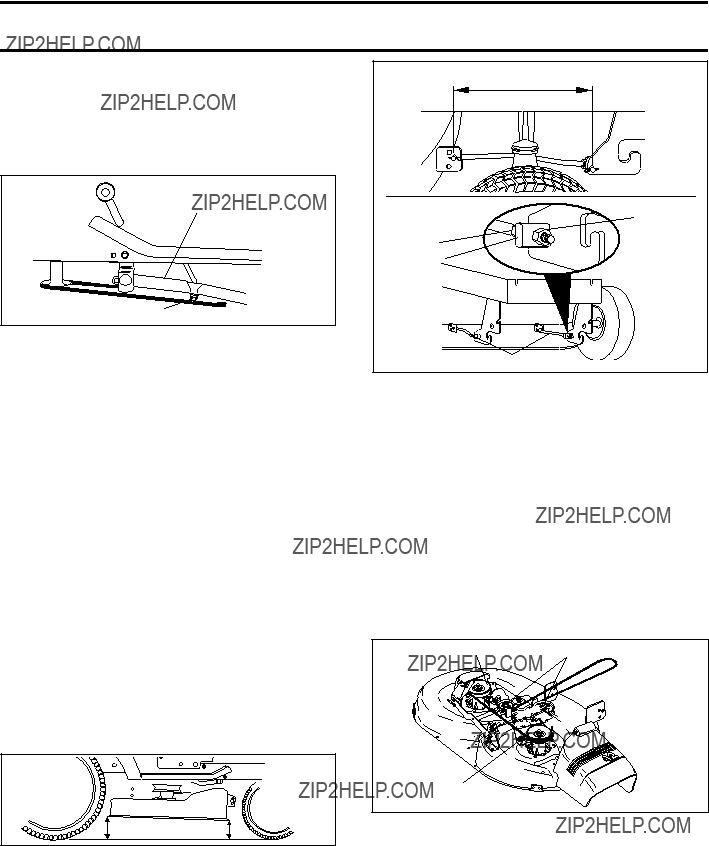
SERVICE AND ADJUSTMENTS
???To raise one side of mower, tighten lift link adjustment nut on that side.
???To lower one side of mower, loosen lift link adjustment nut on that side.
NOTE: Three full turns of adjustment nut will change mower height about 1/8".
???Recheck measurements after adjusting.
SUSPENSION ARM
LIFT LINK ADJUSTMENT NUT
FIG. 19
IMPORTANT: DECK MUST BE LEVEL
THE FOLLOWING
NECESSARY, BE SURE TO ADJUST BOTH FRONT LINKS
EQUALLY SO MOWER WILL STAY LEVEL
To obtain the best cutting results, the mower housing should be adjusted so that the front is approximately 1/8" to 1/2" lower than the rear when the mower is in its highest position.
Check adjustment on right side of tractor. Measure distance ???D??? directly in front and behind the mandrel at bottom edge of mower housing as shown.
???Before making any necessary adjustments, check that both front links are equal in length. Both links should be approximately
???If links are not equal in length, adjust one link to same length as other link.
???To lower front of mower loosen nut ???E??? on both front links an equal number of turns.
???When distance ???D??? is 1/8" to 1/2" lower at front than rear, tighten nuts ???F??? against trunnion on both front links.
???To raise front of mower, loosen nut ???F??? from trunnion on both front links. Tighten nut ???E??? on both front links an equal number of turns.
???When distance ???D??? is 1/8" to 1/2" lower at front than rear, tighten nut ???F??? against trunnion on both front links.
???Recheck

 MANDREL
MANDREL
FIG. 20
BOTH FRONT LINKS MUST BE EQUAL IN LENGTH
NUT "E"
NUT "F"
TRUNNION
FRONT LINKS
FIG. 21
TO REPLACE MOWER BLADE DRIVE BELT
(See Fig. 22)
The mower blade drive belt may be replaced without tools. Park the tractor on level surface. Engage parking brake.
BELT REMOVAL -
???Remove mower from tractor (See ???TO REMOVE MOWER??? in this section of this manual).
???Work belt off both mandrel pulleys and idler pulleys.
???Pull belt away from mower.
BELT INSTALLATION -
???Install new belt in reverse order of removal.
???Make sure belt is in all pulley grooves and inside all belt guides.
???Install mower in reverse order of removal instructions.
MANDREL PULLEY IDLER PULLEYS
MANDREL
PULLEY
FIG. 22
TO ADJUST BRAKE (See Fig. 23)
Your tractor is equipped with an adjustable brake system which is mounted on the side of the transaxle.
If tractor requires more than six (6) feet stopping distance at high speed in highest gear, then brake must be adjusted.
???Depress clutch/brake pedal and engage parking brake.
???Measure distance between brake operating arm and nut ???A??? on brake rod.
20
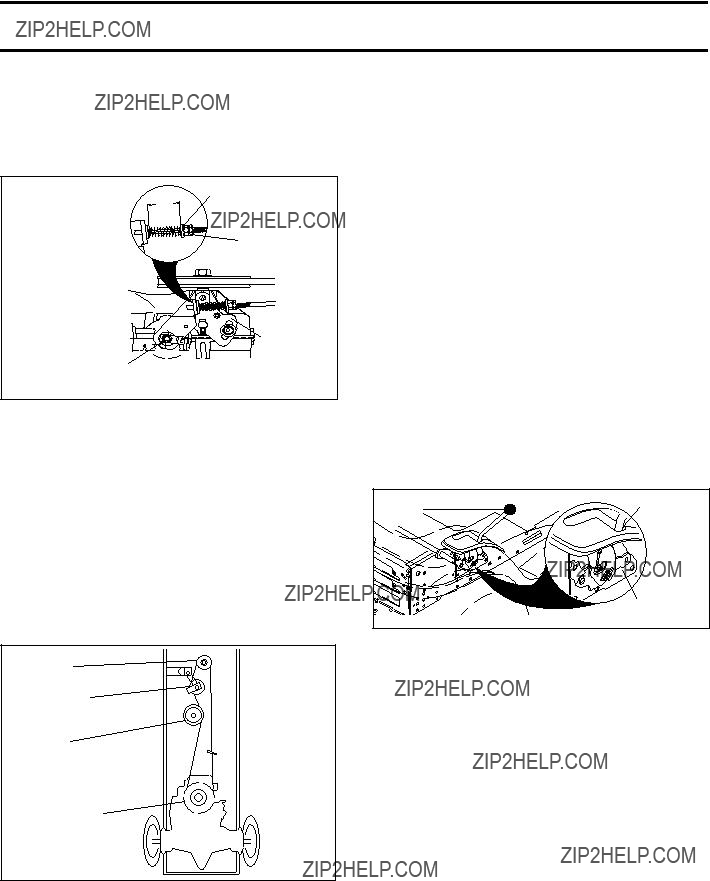
SERVICE AND ADJUSTMENTS
???If distance is other than
???Road test tractor for proper stopping distance as stated above. Readjust if necessary. If stopping distance is still greater than six (6) feet in highest gear, further maintenance is necessary. Contact your nearest au- thorized service center/department.
WITH PARKING BRAKE
TRANSAXLE MOTION CONTROL LEVER
NEUTRAL ADJUSTMENT (See Fig. 25)
The motion control lever has been preset at the factory and adjustment should not be necessary.
???ENGAGED???
NUT ???A???
JAM NUT
OPERATING
ARM
NOTE: If additional clearance is needed to get to adjustment bolt, move mower deck height to the lowest position.
After above adjustment is made, if the tractor still creeps forward or backward while motion control lever is in neutral
DO NOT TOUCH THIS NUT. IF FURTHER BRAKE
ADJUSTMENT IS NECESSARY CONTACT YOUR
NEAREST AUTHORIZED SERVICE CENTER/DEPARTMENT
FIG. 23
TO REPLACE MOTION DRIVE BELT
(See Fig. 24)
Park the tractor on level surface. Engage parking brake. For assistance, there is a belt installation guide decal on bottom side of left footrest.
???Remove mower (See ???TO REMOVE MOWER??? in this section of this manual.)
???Remove belt from stationary idler and clutching idler.
???Pull belt slack toward rear of tractor. Carefully remove belt upwards from transmission input pulley and over cooling fan blades.
???Pull belt toward front of tractor and remove downward from around engine pulley.
???Install new belt by reversing above procedure.
ENGINE
PULLEY
CLUTCHING
IDLER
STATIONARY
IDLER
TRANSMISSION
INPUT PULLEY
FIG. 24
position, follow these steps:
???Loosen the adjustment bolt.
???Move the motion control lever 1/4 to 1/2 inch in the direction it is trying to creep.
???Tighten adjustment bolt securely.
???Start engine and test.
???If tractor still creeps, repeat above steps until satisfied.
FIG. 25
TRANSMISSION REMOVAL/REPLACEMENT
Should your transmission require removal for service or replacement, it should be purged after reinstallation and before operating the tractor. See ???PURGE TRANSMIS- SION??? in the Operation section of this manual.
TO ADJUST STEERING WHEEL ALIGNMENT
If steering wheel crossbars are not horizontal (left to right) when wheels are positioned straight forward, remove steer- ing wheel and reassemble per instructions in the Assembly section of this manual.
FRONT WHEEL
The front wheel
21

SERVICE AND ADJUSTMENTS
TO REMOVE WHEEL FOR REPAIRS
(See Fig. 26)
???Block up axle securely.
???Remove axle cover, retaining ring and washers to allow wheel removal (rear wheel contains a square key - Do not lose).
???Repair tire and reassemble.
???On rear wheels only: align grooves in rear wheel hub and axle. Insert square key.
???Replace washers and snap retaining ring securely in axle groove.
???Replace axle cover.
NOTE: To seal tire punctures and prevent flat tires due to slow leaks, tire sealant may be purchased from your local parts dealer. Tire sealant also prevents tire dry rot and corrosion.
WASHERS
RETAINING
RING
AXLE COVER
SQUARE KEY (REAR
WHEEL ONLY)
FIG. 26
TO START ENGINE WITH A WEAK BATTERY
(See Fig. 27)
CAUTION:
If your battery is too weak to start the engine, it should be recharged. (See "BATTERY" in the CUSTOMER RESPON- SIBILITIES section of this manual).
If ???jumper cables??? are used for emergency starting, follow this procedure:
IMPORTANT: YOUR TRACTOR IS EQUIPPED WITH A 12
VOLT NEGATIVE GROUNDED SYSTEM. THE OTHER
VEHICLE MUST ALSO BE A 12 VOLT NEGATIVE
GROUNDED SYSTEM. DO NOT USE YOUR TRACTOR
BATTERY TO START OTHER VEHICLES.
TO ATTACH JUMPER CABLES -
???Connect each end of the RED cable to the POSITIVE (+) terminal of each battery, taking care not to short against chassis.
???Connect one end of the BLACK cable to the NEGATIVE
???Connect the other end of the BLACK cable to good CHASSIS GROUND, away from fuel tank and battery.
TO REMOVE CABLES, REVERSE ORDER -
???BLACK cable first from chassis and then from the fully charged battery.
???RED cable last from both batteries.
FIG. 27
REPLACING BATTERY (See Figs. 28 and 29)
CAUTION: Do not short battery termi- nals by allowing a wrench or any other object to contact both terminals at the same time. Before connecting battery, remove metal bracelets, wristwatch bands, rings, etc.
Positive terminal must be connected first to prevent sparking from accidental grounding.
???Lift seat pan to raised position and open battery box door.
???Disconnect BLACK battery cable first then RED battery cable and carefully remove battery from tractor.
???Install new battery with terminals in same position as old battery.
???First connect RED battery cable to positive (+) terminal with hex bolt and keps nut as shown. Tighten securely.
???Connect BLACK grounding cable to negative
???Close battery box door.
SEAT PAN
BATTERY
BOX DOOR
FIG. 28
22

SERVICE AND ADJUSTMENTS
KEPS NUT
FIG. 29
TO REPLACE HEADLIGHT BULB
???Raise hood.
???Pull bulb holder out of the hole in the backside of the grill.
???Replace bulb in holder and push bulb holder securely back into the hole in the backside of the grill.
???Close hood.
INTERLOCKS AND RELAYS
Loose or damaged wiring may cause your tractor to run poorly, stop running, or prevent it from starting.
???Check wiring. See electrical wiring diagram in the Repair Parts section.
TO REPLACE FUSE
Replace with 20 amp
TO REMOVE HOOD AND GRILL ASSEMBLY
(See Fig. 30)
???Raise hood.
???Unsnap headlight wire connector.
???Stand in front of tractor. Grasp hood at sides, tilt toward engine and lift off of tractor.
???To replace, reverse above procedure.
HOOD
HEADLIGHT
WIRE
CONNECTOR
FIG. 30
TO ADJUST THROTTLE CONTROL CABLE
(See Fig. 31)
The throttle control has been preset at the factory and adjustment should not be necessary. Check adjustment as described below before loosening cable. If adjustment is necessary, proceed as follows:
???With engine not running, move throttle control lever from slow to choke position. Slowly move lever from choke to fast position.
???Check that holes ???A??? in governor control lever and hole in governor plate
FIG. 31
TO ADJUST CARBURETOR
The carburetor has been preset at the factory and adjust- ment should not be necessary. However, minor adjustment may be required to compensate for differences in fuel, temperature, altitude or load. If the carburetor does need adjustment, see engine manual.
High speed stop is factory adjusted. Do not adjust - damage may result.
IMPORTANT: NEVER TAMPER WITH THE ENGINE
GOVERNOR, WHICH IS FACTORY SET FOR PROPER
ENGINE SPEED. OVERSPEEDING THE ENGINE ABOVE
THE FACTORY HIGH SPEED SETTING CAN BE
DANGEROUS. IF YOU THINK THE
HIGH SPEED NEEDS ADJUSTING, CONTACT YOUR
N E A R E S T A U T H O R I Z E D S E R V I C E C E N T E R /
DEPARTMENT, WHICH HAS PROPER EQUIPMENT AND
E X P E R I E N C E T O M A K E A N Y N E C E S S A R Y
ADJUSTMENTS.
23

STORAGE
Immediately prepare your tractor for storage at the end of the season or if the tractor will not be used for 30 days or more.
CAUTION: Never store the tractor with gasoline in the tank inside a building where fumes may reach an open flame or spark. Allow the engine to cool before storing in any enclosure.
TRACTOR
Remove mower from tractor for winter storage. When mower is to be stored for a period of time, clean it thoroughly, remove all dirt, grease, leaves, etc. Store in a clean, dry area.
???Clean entire tractor (See ???CLEANING??? in the Customer Responsibilities section of this manual).
???Inspect and replace belts, if necessary (See belt re- placement instructions in the Service and Adjustments section of this manual).
???Lubricate as shown in the Customer Responsibilities section of this manual.
???Be sure that all nuts, bolts and screws are securely fastened. Inspect moving parts for damage, breakage and wear. Replace if necessary.
???Touch up all rusted or chipped paint surfaces; sand lightly before painting.
BATTERY
???Fully charge the battery for storage.
???After a period of time in storage, battery may require recharging.
???To help prevent corrosion and power leakage during long periods of storage, battery cables should be discon- nected and battery cleaned thoroughly (see ???TO CLEAN BATTERY AND TERMINALS??? in the Customer Respon- sibilities section of this manual).
???After cleaning, leave cables disconnected and place cables where they cannot come in contact with battery terminals.
???If battery is removed from tractor for storage, do not store battery directly on concrete or damp surfaces.
ENGINE
FUEL SYSTEM
IMPORTANT: IT IS IMPORTANT TO PREVENT GUM
DEPOSITS FROM FORMING IN ESSENTIAL FUEL SYSTEM
PARTS SUCH AS CARBURETOR, FUEL FILTER, FUEL
H O S E , O R T A N K D U R I N G S T O R A G E . A L S O ,
EXPERIENCE INDICATES THAT ALCOHOL BLENDED
FUELS (CALLED GASOHOL OR USING ETHANOL OR
METHANOL) CAN ATTRACT MOISTURE WHICH LEADS
TO SEPARATION AND FORMATION OF ACIDS DURING
STORAGE. ACIDIC GAS CAN DAMAGE THE FUEL
SYSTEM OF AN ENGINE WHILE IN STORAGE.
???Drain the fuel tank.
???Start the engine and let it run until the fuel lines and carburetor are empty.
???Never use engine or carburetor cleaner products in the fuel tank or permanent damage may occur.
???Use fresh fuel next season.
NOTE: Fuel stabilizer is an acceptable alternative in minimizing the formation of fuel gum deposits during stor- age. Add stabilizer to gasoline in fuel tank or storage container. Always follow the mix ratio found on stabilizer container. Run engine at least 10 minutes after adding stabilizer to allow the stabilizer to reach the carburetor. Do not drain the gas tank and carburetor if using fuel stabilizer.
ENGINE OIL
Drain oil (with engine warm) and replace with clean engine oil. (See ???ENGINE??? in the Customer Responsibilities section of this manual).
CYLINDER(S)
???Remove spark plug(s).
???Pour one ounce of oil through spark plug hole(s) into cylinder(s).
???Turn ignition key to ???START??? position for a few seconds to distribute oil.
???Replace with new spark plug(s).
OTHER
???Do not store gasoline from one season to another.
???Replace your gasoline can if your can starts to rust. Rust and/or dirt in your gasoline will cause problems.
???If possible, store your tractor indoors and cover it to give protection from dust and dirt.
???Cover your tractor with a suitable protective cover that does not retain moisture. Do not use plastic. Plastic cannot breathe which allows condensation to form and will cause your tractor to rust.
IMPORTANT: NEVER COVER TRACTOR WHILE ENGINE
AND EXHAUST AREAS ARE STILL WARM.
24

TROUBLESHOOTING POINTS
25

TROUBLESHOOTING POINTS
26

REPAIR PARTS
TRACTOR - - MODEL NUMBER PO165H42A
SCHEMATIC
27

REPAIR PARTS
TRACTOR - - MODEL NUMBER PO165H42A
ELECTRICAL
25
16
16
33
30
28
27
2
1
28
REPAIR PARTS
TRACTOR - - MODEL NUMBER PO165H42A
ELECTRICAL
KEY PART
NO. NO.DESCRIPTION
1144925 Battery 12 Volt 25 Amp
274760412 Bolt Hex Hd
NOTE: All component dimensions give in U.S. inches 1 inch = 25.4 mm.
29
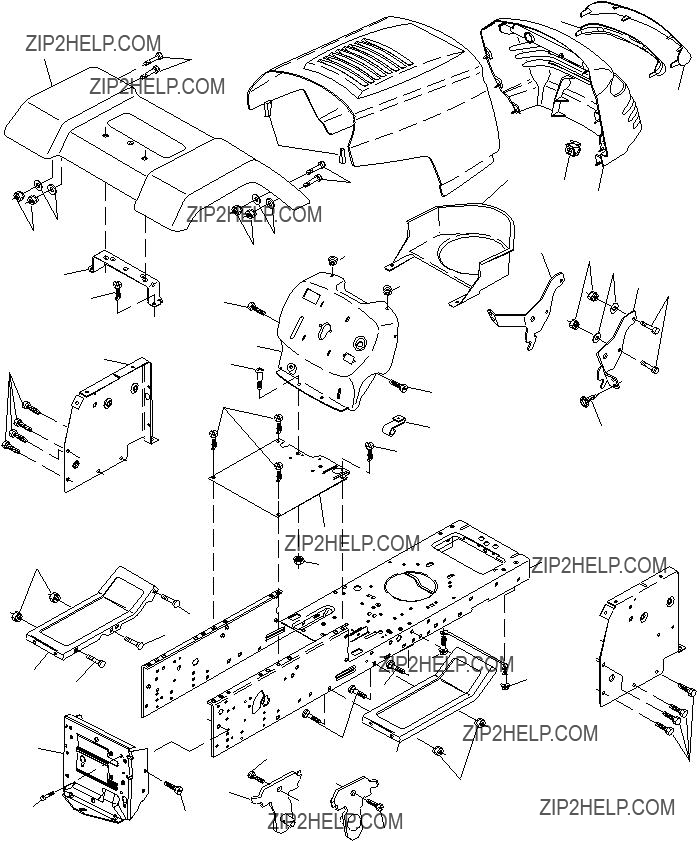
REPAIR PARTS
TRACTOR - - MODEL NUMBER PO165H42A
CHASSIS AND ENCLOSURES
212
30
17 
24
29
3
35
37
33
206
3
38 205
205
58
12
28
53
51
52
55
57
54
1
13 
 145 37
145 37
208
30
REPAIR PARTS
TRACTOR - - MODEL NUMBER PO165H42A
CHASSIS AND ENCLOSURES
9168348X012 Dash
1072140608 Bolt RdHd Sqnk.
11155927 Panel Asm. Dash Lh
1574180512 Screw Mach Trhd
1673510500 Nut Keps
17159639X428 Hood
18 126938X Bumper Hood
2474780616 Bolt Fin Hex
2519131312 Washer 13/32 x 13/16 x 12 Ga.
2673800600 Nut Lock Hex w/Insert
29140273X599 Lens Grille Private label
30169467X428 Fender Asm
33145244X428 Footrest
34145243X428 Footrest
3572110606 Bolt RdHd Sht. Sqnk.
3717490508 Screw Thdrol
38169834 Bracket Asm. Pivot Mower Rear
5173800400 Nut Lock Hex W/Ins.
5219091416 Washer 9/32 x 7/8 x 16 Ga.
5774780412 Bolt Fin Hex
58150127 Air Duct Private Label
20817670608 Screw Thdrol
20917000612 Screw Hex Wsh Thdrol
NOTE: All component dimensions given in U.S. inches 1 inch = 25.4 mm
31
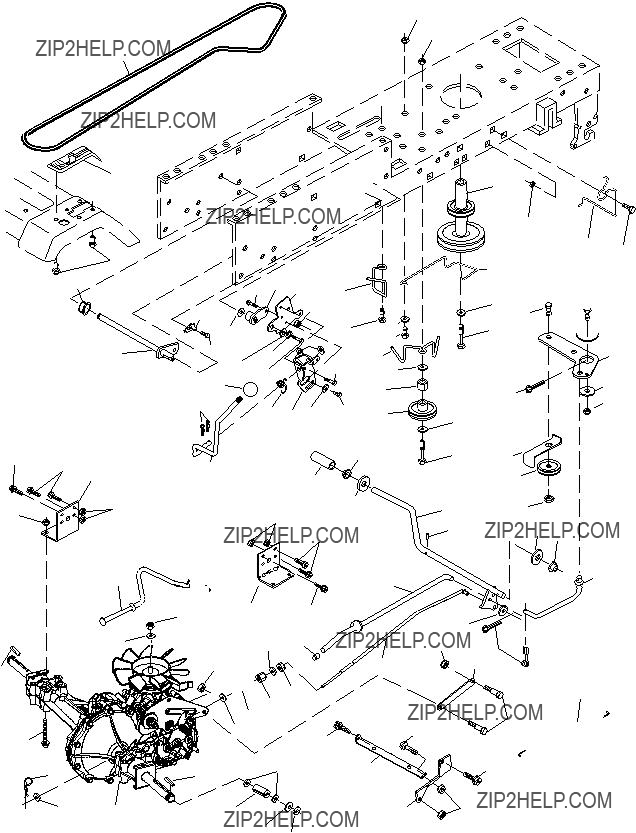
REPAIR PARTS
TRACTOR - - MODEL NUMBER PO165H42A
DRIVE
51
51
57
70
116

 202
202
 150 48
150 48
151
51
32
REPAIR PARTS
TRACTOR - - MODEL NUMBER PO165H42A
DRIVE
1 inch = 25.4 mm
33
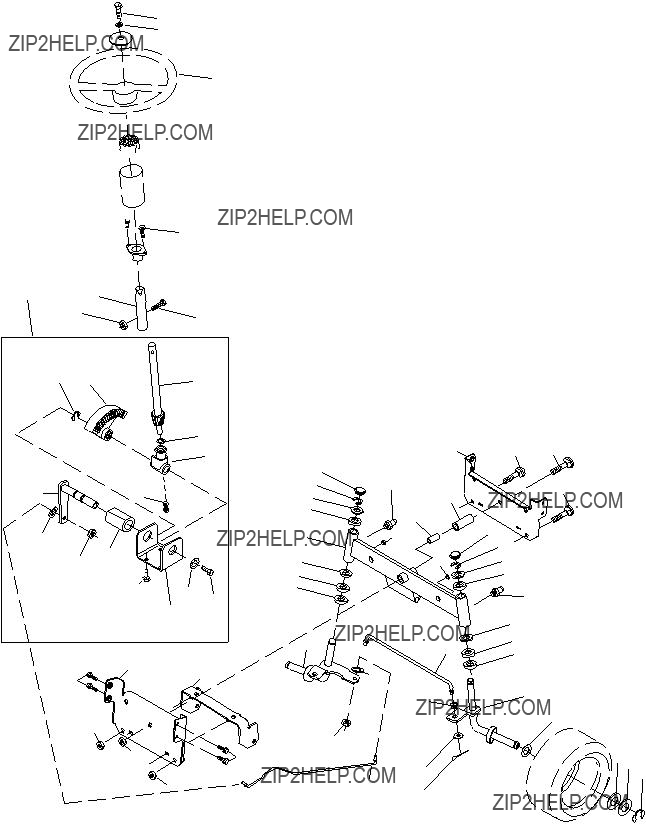
REPAIR PARTS
TRACTOR - - MODEL NUMBER PO165H42A
STEERING ASSEMBLY
 38
38
63
11
 39
39
1
 41
41
 42
42
37 

 36
36
26
4
34
REPAIR PARTS
TRACTOR - - MODEL NUMBER PO165H42A
STEERING ASSEMBLY
KEY PART
NO. NO.DESCRIPTION
1140044X428 Wheel Steering Auto Black
2154427 Axle Asm Front
3156483 Spindle Asm Lh
4157473 Spindle Asm Rh
6121748X Washer 25/32 X 1 5/8 X 16ga
719272016 Washer 27/32 X 1 1/4 X 16 Ga
812000029 Ring Klip
22165857 Screw Hex Wsh Hd Torx
23165851 Shaft Asm Pittman
2819131416 Washer 13/32 X 7/8 X 16ga
2917060612 Screw
36155099 Bushing Strg 5/8 Id Dash
37152927 Screw TT
38140045X428 Insert Cap Strg
3919133812 Washer 13/32 x
41100711L Adaptor Wheel Strg 640/ 635id
42145054X428 Boot Dash Steering
43121749X Washer 25/32 X 1 1/4 X 16 Ga
62167902 Kit Steering Assembly Service
6374780616 Bolt Fin Hex
7919132012 Washer 13/32 x
8074950612 Bolt Hex Nylon
NOTE: All component dimensions given in U.S. inches 1 inch = 25.4 mm
35
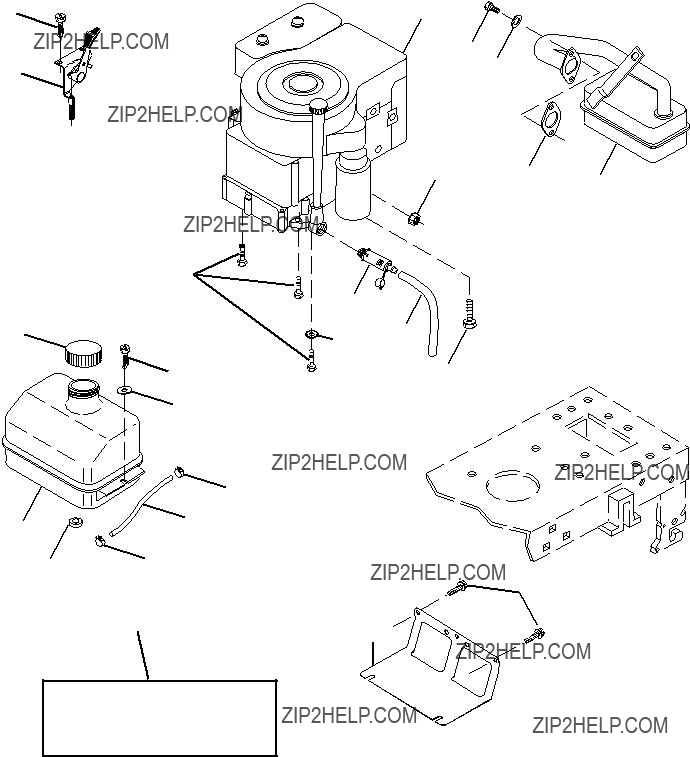
REPAIR PARTS
TRACTOR - - MODEL NUMBER PO165H42A
ENGINE
2
1
32
31
40
3
72
62
8113
33
37
33
45
29
23
4
OPTIONAL EQUIPMENT
Spark Arrester
36
REPAIR PARTS
TRACTOR - - MODEL NUMBER PO165H42A
ENGINE
13165291 Gasket 1 313 Id Tin Plated
14148456 Tube Drain Oil Easy
31109202X Tank Fuel 1 25 Fr
32140527 Cap Asm Fuel W/sym Vented
33123487X Clamp Hose Blk
4417670412 Screw Hexwsh Thdrol
4517000612 Screw Hex Wsh Thdrol
4619091416 Washer 9/32 X 7/8 X 16ga
NOTE: All component dimensions given in U.S. inches 1 inch = 25.4 mm
37

REPAIR PARTS
TRACTOR - - MODEL NUMBER PO165H42A
SEAT ASSEMBLY
1
14
10
5
6
22
24
5
26
16
 25 15
25 15 
23
2
21
7124181X Spring Seat Cprsn 2 250 Blk Zi
817000616 Screw
919131614 Washer 13/32 x 1 x 14 Ga
10174894 Pan Pnt Seat (blk )
12121246X Bracket Pnt Mounting Switch
13121248X Bushing Snap Blk Nyl 50 Id
1472050412 Bolt Rdhd Sht Nk
15134300 Spacer Split 28 x 96 Yel Zinc
16121250X Spring Cprsn 1 27 Blk Pnt
17123976X Nut Lock 1/4 Lge Flg Gr 5 Zinc
2371110814 Bolt Hex Black
2419171912 Washer 17/32 x
25127018X Bolt Shoulder
2610040800 Lockwasher
NOTE: All component dimensions given in U.S. inches 1 inch = 25.4 mm
38

REPAIR PARTS
TRACTOR - - MODEL NUMBER PO165H42A
DECALS
1
6
11
20
14
WHEELS & TIRES
NOTE: All component dimensions given in U.S. inches 1 inch = 25.4 mm
39

REPAIR PARTS
TRACTOR - - MODEL NUMBER PO165H42A
MOWER LIFT
11
19
13
31
32
13
31
32
7
8
5
40
REPAIR PARTS
TRACTOR - - MODEL NUMBER PO165H42A
MOWER LIFT
412000002 E Ring
519211621 Washer 21/32 x 1 x 21 Ga.
31169865 Bearing Pvt Lift
3273540600 Nut Crownlock
NOTE: All component dimensions given in U.S. inches 1 inch = 25.4 mm
41
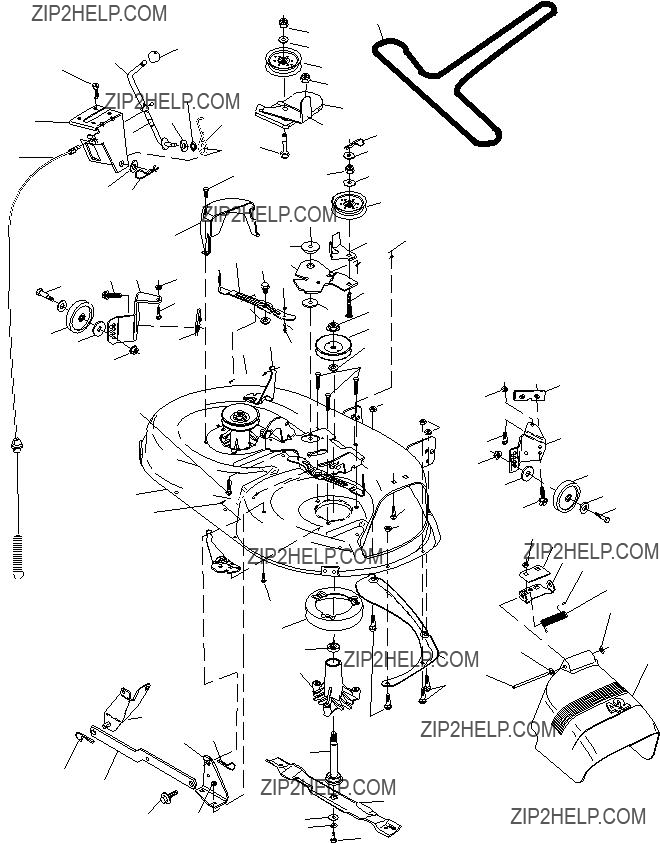
REPAIR PARTS
TRACTOR - - MODEL NUMBER PO165H42A
MOWER DECK
157
158
151
152
153 154
113 111
116
120 
117
119
118
34
1
147
142 
2
21
21 22
23
24
25
4 149
13
5
6
11
42
REPAIR PARTS
TRACTOR - - MODEL NUMBER PO165H42A
MOWER DECK
43

SERVICE NOTES
44

SERVICE NOTES
45
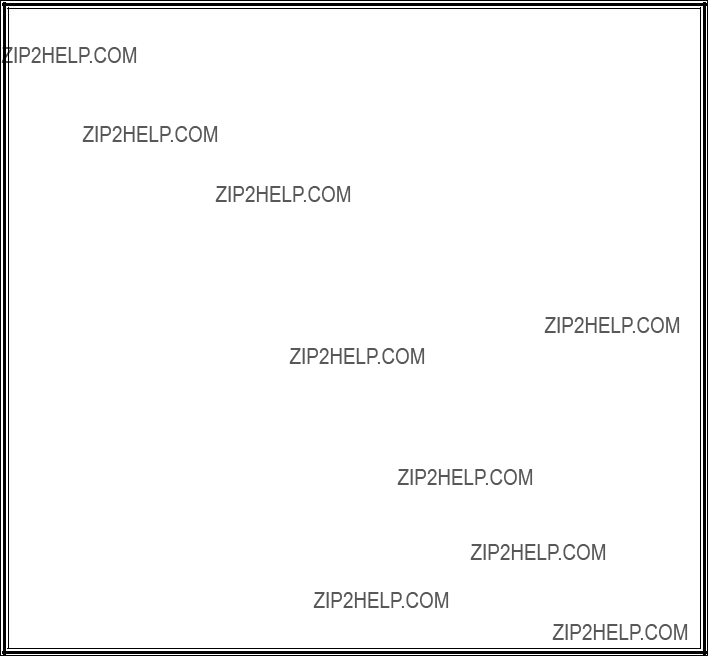
LIMITED WARRANTY
The Manufacturer warrants to the original consumer purchaser that this product as manufactured is free from defects in materials and workmanship. For a period of two (2) years from date of purchase by the original consumer purchaser, we will repair or replace, at our option, without charge for parts or labor incurred in replacing parts, any part which we find to be defective due to materials or workmanship. This Warranty is subject to the following limitations and exclusions.
1.This warranty does not apply to the engine, other than EHP manufactured transaxle/transmission components, battery (except as noted below) or components parts thereof. Please refer to the applicable manufacturer's warranty on these items.
2.Transportation charges for the movement of any power equipment unit or attachment are the responsibility of the purchaser. Transportation charges for any parts submitted for replacement under this warranty must be paid by the purchaser unless such return is requested by Electrolux Home Products.
3.Battery Warranty: On products equipped with a Battery, we will replace, without charge to you, any battery which we find to be defective in manufacture, during the first ninety (90) days of ownership. After ninety (90) days, we will exchange the Battery, charging you 1/12 of the price of a new Battery for each full month from the date of the original sale. Battery must be maintained in accordance with the instructions furnished.
4.The Warranty period for any products used for rental or commercial purposes is limited to 90 days from the date of original purchase.
5.This Warranty applies only to products which have been properly assembled, adjusted, operated, and main- tained in accordance with the instructions furnished. This Warranty does not apply to any product which has been subjected to alteration, misuse, abuse, improper assembly or installation, delivery damage, or to normal wear of the product.
6.Exclusions: Excluded from this Warranty are belts, blades, blade adapters, normal wear, normal adjustments, standard hardware and normal maintenance.
7.In the event you have a claim under this Warranty, you must return the product to an authorized service dealer.
Should you have any unanswered questions concerning this Warranty, please contact:
giving the model number, serial number and date of purchase of your product and the name and address of the authorized dealer from whom it was purchased.
THIS WARRANTY DOES NOT APPLY TO INCIDENTAL OR CONSEQUENTIAL DAMAGES AND ANY IMPLIED WARRAN- TIES ARE LIMITED TO THE SAME TIME PERIODS STATED HEREIN FOR OUR EXPRESSED WARRANTIES. Some areas do not allow the limitation of consequential damages or limitations of how long an implied Warranty may last, so the above limitations or exclusions may not apply to you. This Warranty gives you specific legal rights, and you may have other rights which vary from locale to locale.
This is a limited Warranty within the meaning of that term as defined in the
46
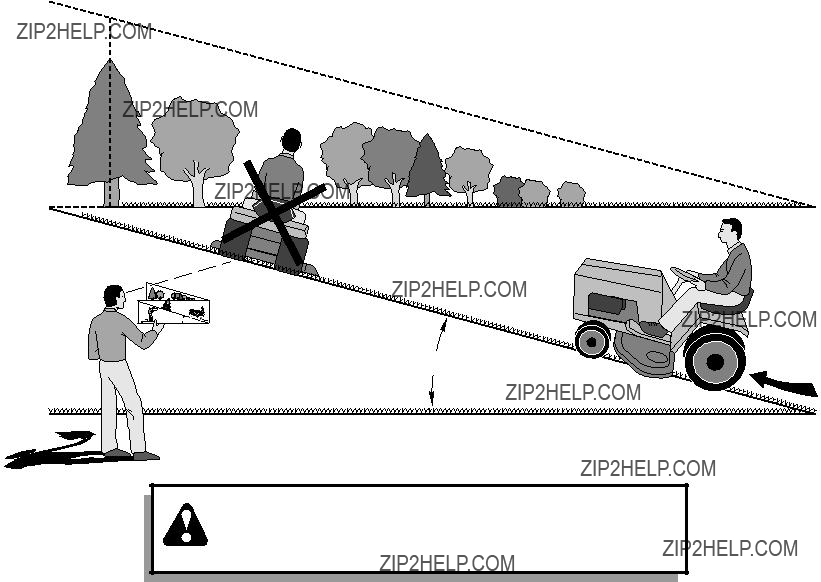
SUGGESTED GUIDE FOR SIGHTING SLOPES FOR SAFE OPERATION
SIGHTING
GUIDE
ONLY RIDE UP AND DOWN HILL,
NOT ACROSS HILL
47
SIGHT AND HOLD THIS LEVEL WITH
SKY LINE OR TREE.
15?? MAX.
Operate your Tractor up and down the face of slopes (not greater than 15??), never across the face. Make turns gradu- ally to prevent tipping or loss of control. Exercise extreme caution when changing direction on slopes.
